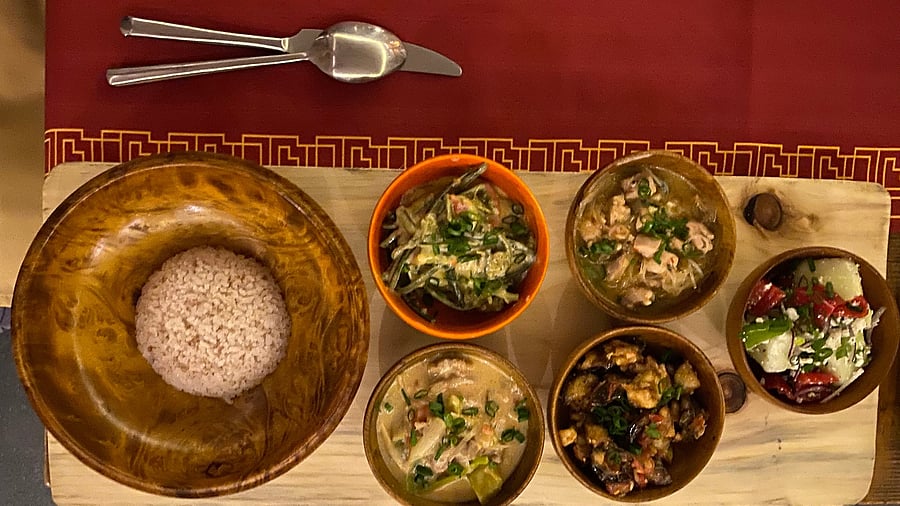
Image for representation,
Credit: iStock Photo
When one thinks of Bhutanese cuisine, the first dish that often comes to mind is Ema Datshi, Bhutan’s national dish, combining fiery chilli peppers (ema) with cheese (datshi). However, Bhutanese cuisine is much more than just Ema Datshi.
In the Land of the Thunder Dragon, food culture — still relatively lesser-known globally compared to other Asian cuisines — is influenced by a variety of factors such as the climate, diverse ethnic groups, and the neighbouring countries of India, Nepal, and Tibet.
In The Traditional and Ethnic Cuisine of Bhutan, Tashi Tshering Bhutia and Purnendu Bagchi explore how Bhutan’s high-altitude geography and climate have impacted local agriculture, shaping the food traditions of the country. The availability of certain food groups has been instrumental in giving Bhutanese cuisine its distinct character.
Bhutan’s cuisine revolves around the agricultural calendar, using seasonal ingredients and showcasing unique flavours. The diet is based on staple foods such as rice, maize, and buckwheat, with dairy products like cheese and butter playing a significant role. Meat, typically pork and beef, also features prominently. In the colder, high-altitude regions, dried meat and vegetables are commonly used in dishes during the harsh winter months.
“Our food is known for its simplicity,” says guide Tshewang Phuntso. “Typically made with locally grown ingredients and spices, it’s an integral part of Bhutan’s cultural identity, reflecting the country’s history, geography, and traditions.” Cooking techniques and culinary rituals that have been passed down through generations reflect the country’s rich culinary heritage.
Given Bhutan’s mountainous terrain and climate, its cuisine is designed to be comforting and warm. Signature dishes like nutty red rice and buckwheat pancakes (khurle) are typically enjoyed with meat or vegetables such as spinach, pumpkins, turnips, radishes, tomatoes, onions, green beans, and riverweed.
Soups and stews made with meat, vegetables, lentils, ferns, cheese, and butter are staples. Dishes frequently incorporate turnip leaves — fresh or sun-dried during winter — fiddlehead ferns, and a variety of foraged greens. Bhutan’s rich biodiversity also supports over 400 species of mushrooms, including matsutake, chanterelles, shiitake, and oyster mushrooms. Phuntso mentions that the matsutake mushroom, known as the wild pine mushroom, is harvested in places like Genekha, a small village near Thimphu, and the beautiful Ura Valley in Bumthang, where the mushroom harvest is celebrated with a festival.
But if there’s one constant in Bhutanese cuisine, it’s the chilli.
Whether fresh or dried, chillies are not merely used as a seasoning in Bhutan — they are considered a vegetable. The ubiquitous Ema Datshi is only one of many dishes where chillies shine, along with its variations like Kewa Datshi (thin potato slices cooked with butter and cheese), Shamu Datshi (mushrooms in a cheesy stew), and Shakam Datshi (Bhutanese dried beef in cheese). However, it is in Ezay, a spicy chilli condiment served with nearly every meal, where chillies truly come into their own. Not only does it enhance flavour, but it is also believed to aid digestion and boost metabolism, further emphasising the central role of spice in Bhutanese food culture. A majority of Bhutanese dishes make use of mountain produce, meat, and dairy. These include Phaksha Paa (slices of pork stir-fried with whole dried red chillies and mountain vegetables), Shakam Paa (dried beef cooked with potatoes, radishes, and ginger), Juma (a sausage made from meat, rice, and Sichuan pepper), Jasha Maroo (diced chicken with vegetables and chillies), Hoentay (vegetarian dumplings from the Haa Valley), and Gondo Datshi (the Bhutanese version of scrambled eggs).
Side dishes like Goen Hogay (a cucumber salad with onions, tomatoes, and red chillies), Khatem (thinly sliced and fried bitter gourd), and Jaju (a light soup made with milk, butter, and turnip leaves) offer a refreshing balance to the heavier, spicier dishes. Other popular food items include momos (dumplings filled with vegetables, mushrooms, or minced meat) and Puta (buckwheat noodles stir-fried with vegetables and/or meat). The Bhutanese also consume copious amounts of tea throughout the day, with chai (milk tea) or Suja (black tea frothed with butter and salted) being the most common. Kinley Wangchuck, who runs a homestay in Haa with his wife Wangmo, shares that the most common Bhutanese snacks served with tea include Zaow (puffed and beaten rice), Tengma (beaten maize), and Khabzey (deep-fried fritters made with flour and sugar). He also recommends trying Chhurpi, the hard yak cheese that is often seen hanging like garlands at stalls and shops, chewed by Bhutanese as they go about their day.
On special occasions, local liquor takes centre stage, often served in traditional containers known as Tongba. Ara, the national drink, is made from rice, barley, maize, millet, or wheat, while Chang, a fermented rice or millet beer, offers a tangy flavour. Food is deeply embedded in Bhutanese culture, symbolising community and hospitality. Meals are a time for families and friends to come together, and the act of eating together is highly valued in traditional Bhutanese culture, reflecting respect for food and shared experiences, says Phuntso.